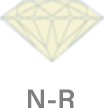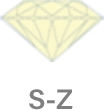The second most important of the 4Cs is color, which refers to a diamond's lack of color. The less color, the higher the grade.
After diamond cut, diamond color is the second most important characteristic to consider when choosing a diamond. The highest quality diamonds are colorless, while those of lower quality have noticeable color, which manifests as pale yellow in diamonds.
The Gemological Institute of America (GIA) grades diamond color on a scale of D (colorless) to Z (light yellow or brown). D-Z diamonds are also known as white diamonds, even though most diamonds, including H color diamonds and G color diamonds, have varying amounts of color.
The GIA diamond color scale is the leading industry standard of diamond color grading. Before this was the standard, other color grading scales used A, B and C, so GIA started their scale at D to avoid confusion.
There are six categories on the GIA diamond chart, with color grades that range from absolutely colorless to light in color. Diamonds rated D are the most devoid of color and very rare, whereas G color diamonds and H color diamonds are near colorless, and since they’re priced lower they are excellent value diamonds. The more you move down the color chart, the lower the color grade is, and the more noticeable the light yellow hue becomes.There are six categories on the GIA diamond chart, with color grades that range from absolutely colorless to light in color. Diamonds rated D are the most devoid of color and very rare, whereas G color diamonds and H color diamonds are near colorless, and since they’re priced lower they are excellent value diamonds. The more you move down the color chart, the lower the color grade is, and the more noticeable the light yellow hue becomes.

While there are differences in color between D, E, and F diamonds, they can be detected only by a gemologist in side by side comparisons, and rarely by the untrained eye.
D-F diamonds should only be set in white gold / platinum. Yellow gold reflects color, negating the diamond's colorless effect.

While containing traces of color, G-J diamonds are suitable for a platinum or white gold setting, which would normally betray any hint of color in a diamond.
Because I-J diamonds are more common than the higher grades, they tend to be a great value. An I-J diamond may retail for half the price of a D diamond. Within the G-J range, price tends to increase 10-20% between each diamond grade.

Beginning with K diamonds, color (usually a yellow tint) is more easily detected by the naked eye.
Set in yellow gold, these warm colored diamonds appeal to some, and are an exceptional value. Others will feel they have too much color. Due to its perceptible color tint, a K diamond is often half the price of a G diamond.

Diamonds in the N-R color range have an easily seen yellow or brown tint, but are much less expensive than higher grades.
Lumera does not carry diamonds in this color range due to a lack of demand. If you desire a diamond in this range, request a price quote using the custom diamond search.

For almost all customers, S-Z diamonds have too much color for a white diamond.
Lumera does not carry diamonds in this color range. If you desire a diamond in this range, request a price quote using the custom diamond search.